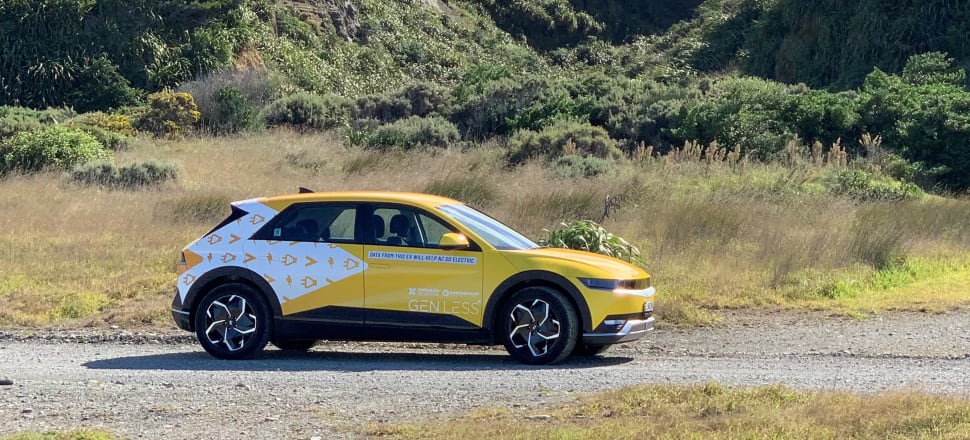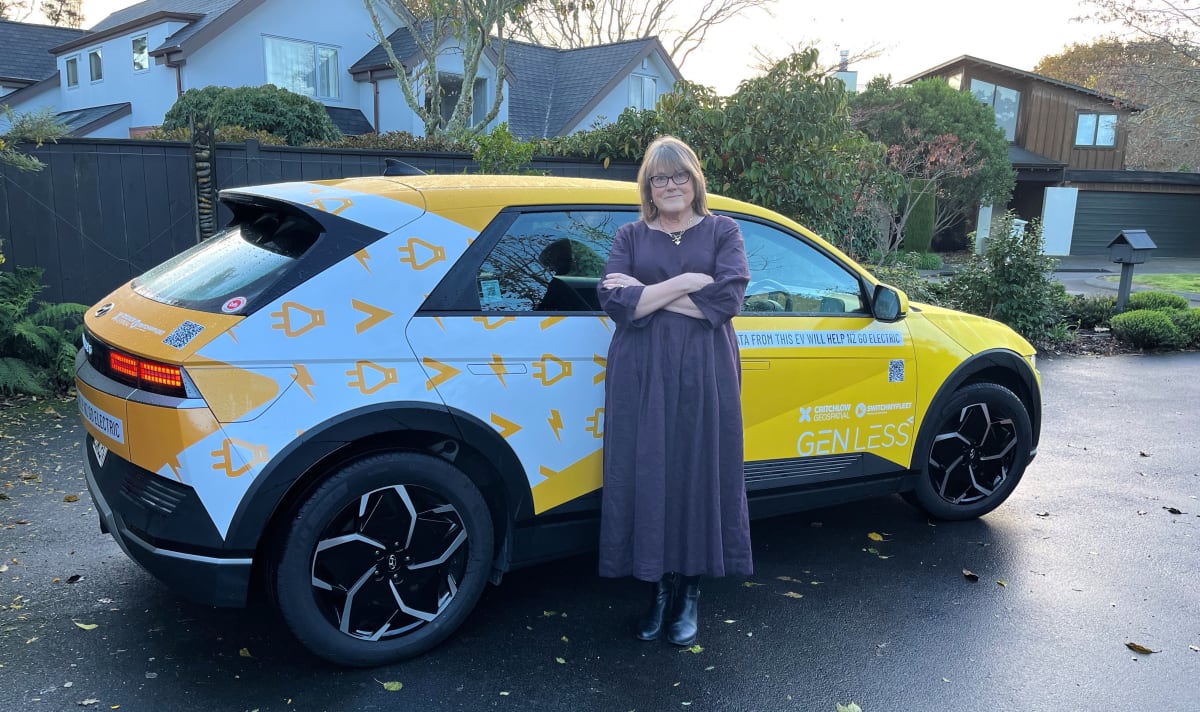
A light electric vehicle has been quietly touring New Zealand’s roads for the past six months gathering data around battery life to help companies prepare a business case for a switch from combustion engines to EVs | Content partnership
A grant from the Low Emissions Transport Fund in November 2022 saw location intelligence company Critchlow Geospatial purchase a Hyundai IONIQ 5. It's using the car to calibrate its SwitchMyFleet software, refining the data to get a real-world picture of battery performance. In a world ridden with range anxiety, the tool allows people to choose the most appropriate vehicle and battery size for their needs and confirm they can complete their journeys.
The car carries a telematics device and SwitchMyFleet measures the impact of a range of payloads, roads, traffic volumes, topography, and temperature conditions on the Hyundai’s 58kWh battery. That data is combined with geospatial information, route optimisation algorithms and the physics of a moving vehicle. The outputs are the bespoke metrics for a business case.
READ MORE: * Companies accelerate move to EVs * EV etiquette, EV envy – and EV-erything in between
Critchlow Geospatial’s general manager, Mary Sue Critchlow says the pilot can revolutionise EV fleet procurement, producing data that helps people make good choices.
“We know that most people will try to buy the biggest battery they can afford, thinking that it’s the best decision. But that increases the weight of the vehicle, so therefore it’s going to use more energy, it really increases the cost, reduces the payload, and when it comes to be decommissioned, it has the greatest environmental impact.“

Critchlow says SwitchMyFleet gives people the opportunity to compare energy performance on the same route in carbon-driven and electric environments and realise that fleet change is far from a straight vehicle-for-vehicle swap out.
“For example, local councils who are driving say, 40 internal combustion engine cars, want 40 electric vehicles that are similar, instead of saying, ‘How many of these cars are working optimally today?’”
She believes the tool should be used by every company and government organisation doing fleet procurement (cars, vans, light and medium trucks) to validate their decision and the fiscal logic of good sustainable practice.
“That would be my wish, that these artefacts are included in every board proposal.”
Transition focus
Transport was responsible for an estimated 39 percent of New Zealand’s CO2 emissions and 17 percent of gross emissions in 2019. The Ministry of Transport has a goal to reduce transport emissions by 41 percent by 2035.
Decarbonisation of transport is a key focus for the Energy Efficiency and Conservation Authority (EECA), one of the partners in the trial. EECA transport director, Richard Briggs says that at 880 cars per 1000 people, New Zealand has high rates of vehicle ownership. He says overall we have around 4.5 million cars and light vehicles on the road and some 75,000 or less than two per cent are electric. EECA wants to encourage a shift to electrification by identifying the barriers to doing so.
Briggs says around 30 percent of the cost of an EV is the battery, so SwitchMyFleet’s ability to right-size the battery is really exciting.
“It’s a significant contributing factor to businesses optimising their fleet for transition and doing so with confidence,” he says. “If you can get a driver to drive efficiently in an EV, you can get away with a smaller battery.”
Hills are the friend of the EV driver. Elevation provides regenerative energy on the downhill run, returning power to the battery. – Mary Sue Critchlow, Critchlow Geospatial
There have been some surprising results arising from the pilot. The layperson might consider that when comparing two routes, say Christchurch to Akaroa return, and Christchurch to Ashburton and back, that the trip over the Canterbury Plains to Ashburton would use less energy. Not so, according to Critchlow.
“Some might think, I’ll have to spend a couple of hours in Akaroa charging up, which is lost money and time for the driver and crew.”
In fact, she explains, elevation provides regenerative energy on the downhill run, returning power to the battery, so drivers don’t need to stop to recharge. And a straight, flat road can mean the driver travels faster, using more energy. So hills are the friend of the EV driver.
Increasing pressure for change
The pilot is timely, coinciding with the implementation of New Zealand’s climate related financial disclosures legislation. Since the start of the year, around 200 financial institutions and large listed companies have been required to publicly report their climate risk or exposure under the Financial Sector (Climate-related Disclosures and Other Matters) Amendment Act. Affected organisations are required to publish disclosures in accordance with climate standards published by the External Reporting Board (XRB). Similar rules have kicked in in the United Kingdom, Europe and Singapore, with Australia to follow.
An entity must report its own climate related risks and opportunities; the emissions from the energy it uses and the emissions in both its upstream and downstream value chain. And this is where small to medium domestic businesses and exporters are affected. While not directly obliged to disclose by the legislation, they may well be asked for information by their customers.

Dr Amelia Sharman is director of sustainability reporting at the XRB. She says the regime invites business to consider the climate related risks and opportunities they face.
“Banks and insurers will be looking for information from entities that are in their value chain to help them report. We’re really starting to see a lot of information requests down into entities they might be providing finance to. Then when you come to the large, listed companies, it’s the same.”
And she says while most exporters won’t themselves be covered by the regime, their overseas customers will.
Integrated decision making, not box ticking
“Understanding the risks and opportunities from climate change is going to become a core piece of organisational data that we encourage businesses to capture.”
Sharman says the new requirement to make climate related disclosures is not a compliance or accounting procedure.
“It’s really a core strategy exercise, because the disclosures are asking entities to consider how climate resilient they are and how they can transition to a low emissions future. We’re really expecting changes to entities’ business models and strategies as a result of the disclosures.”
Sharman says businesses having a richer body of data from applications like SwitchMyFleet to improve decision making can only be a good thing.
“I’m excited about the potential to enable companies to think about how they transition, how they achieve low emissions targets. Any innovative tool like this is going to absolutely enhance a business’ own product. TCO is great, but SwitchMyFleet brings together a whole lot more, richer information about your operating costs.”
Critchlow Geospatial wants to see SwitchMyFleet used by the top 200 entities impacted by the new climate related disclosures, and those in their value chains. The SwitchMyFleet tool is free and can be found here.
Other tools available for businesses looking to reduce their carbon emissions include: * Vehicle total cost of ownership calculator * Sustainable supply chain toolbox * Climate action toolbox
In 2021, Critchlow Geospatial’s SwitchMyFleet was recognised at the Geospatial World Forum with an award for excellence and innovation in location-based services. The company believes it has a unique proposition worldwide. In time it plans to target other countries where incoming environmental reporting legislation makes it a must-have. But first, the pilot’s backers want Kiwi businesses to start using the application, transition to electric vehicles and enjoy greater productivity.
Hyundai is a content partner of Newsroom







